 |
||
|
||
| ||
Part 3. Thermaltake, Titan and Zalman Coolers
Part 1. Adda, AVC, Cooler Master and Evercool Coolers
Part 2. GlacialTech, Molex and Spire CoolersThermaltake Volcano 5, Volcano 6Cu, Volcano 6Cu+ and Volcano 8 SEVolcano 5, Volcano 6Cu and Volcano 6Cu+ coolers from the Thermaltake's budget Socket A line were tested several times already during two years and made a good showing. But today, with the requirements getting higher, these models got paler.  Left to right: Thermaltake Volcano 6Cu and Volcano 6Cu+ They look very similar to Evercool ND12-625 having the same old heatsink of the same size, the same fan dimensions and similar mounts. The only difference from ND12-625 is a promising copper disc pressed into the heatsink base of Volcano 6Cu and Volcano 6Cu+.  However, the problems we noticed the first time are not solved yet: poor molding (in some samples the copper disc nearly falls out of the heatsink), badly processed copper disc surface and a short fan's service life affected their thermal parameters and overall functionality. Because of the poor-quality and noisy fan Volcano 6Cu+ falls into the last position in the technical rating. The new budget model Volcano 8 SE looks much better; it features a compact extrusion heatsink, 65x63x32 mm, with good fin parameters (trapezoid shape, 0.8 mm thick at the base and 0.4 mm at the top), a carefully soldered-in copper plate, a high-grade fan, 60x60x10 mm and a 6-point mount. 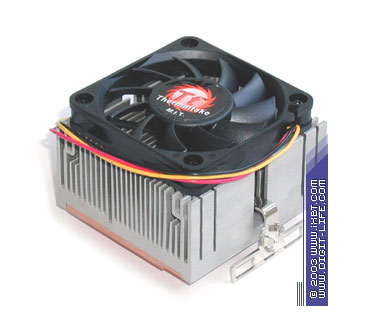
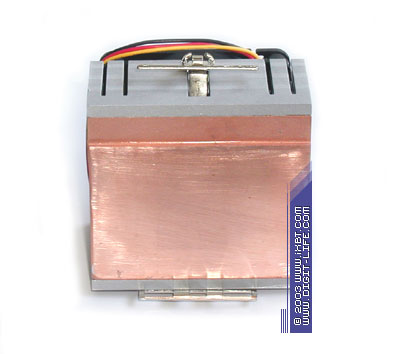 Thermaltake Volcano 8 Volcano 8 SE has decent thermal effectiveness (mostly due to the copper plate) and a relatively low noise level (44 dBA, with the fan, 60x60x10 mm, working at 5000 rpm). This model has better functionality than its budget predecessors and takes a higher position in the technical rating. It could climb up the economical rating as well if it were not for its high price. Thermaltake Volcano 7+Volcano 7+ had the best thermal effectiveness for quite a long time thanks to the massive copper heatsink, 69x65x35 mm, with excellent skived fin parameters and a powerful fan, 70x70x25 mm, rotating at 6000 rpm. 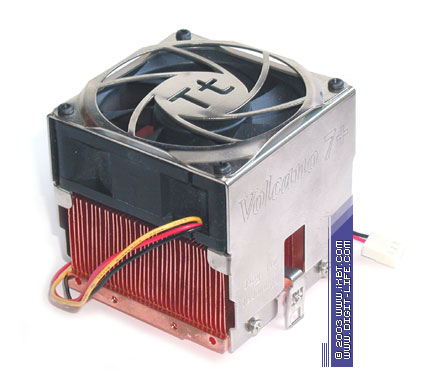 Thermaltake Volcano 7+ But its advantages are outweighed by the fact that the cooler is the extremely noisy and weighty (700g which can be really dangerous for the processor core and socket). The power supply adapter which could lower the rotational speed can make it quieter, but it also affects thermal effectiveness. Now, when Volcano 7+ is outpaced by stronger competitors, the situation gets even worse. This model gets into the end of the technical rating irregardless of the fan's speed. Its low-noise version looks more attractive, but in the economical rating it takes a rather low position. Volcano 7+ doesn't have a good chance to win customers' hearts. Thermaltake Volcano 7, Volcano 9 and Volcano 9 CoolModVolcano 7 came onto the scene 1.5 years ago and keeps on catching users' eyes. It sports a big extrusion heatsink, 70x68x45 mm, with a pressed-in copper disc and an impressive fan, 80x80x25 mm, with the temperature control support. 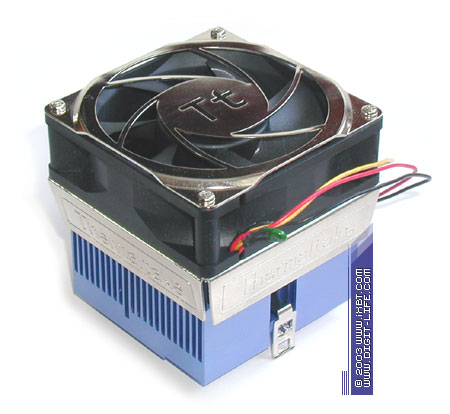 Thermaltake Volcano 7 In spite of its large dimensions, Volcano 7 can't boast of its fin parameters: 1 mm thick fin and a console factor equal to 17. The copper disc pressed into the base doesn't help much.  Although the copper plate greatly reduces the overall thermal resistance, Volcano 7 doesn't look much better than Volcano 6Cu and Volcano 6Cu+. Moreover, it can be difficult to install such a bulky cooler on some mainboards. Therefore, Volcano 7 doesn't take a decent position in the finals. The new Thermaltake's cooler Volcano 9 is actually a tuned Volcano 7: it incorporates an identical heatsink with a bit different frills and a catchy orange fan with auto temperature control and manual revolutions control.  Thermaltake Volcano 9 We expected that Volcano 9 would be at least as efficient as Volcano 7. It proved to be a good performer for the Athlon XP (Palomino) based system, but on the Thoroughbred based one its scores fell down markedly because the mount skewed the cooler a little when pressing the heatsink and because the copper disc has its surface unprocessed. 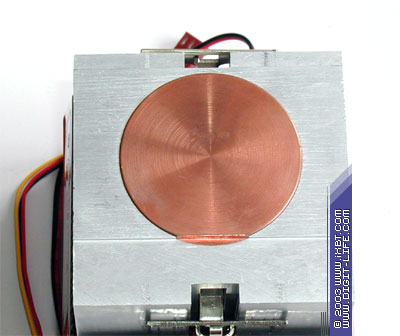 It doesn't matter much in case of the big Palomino core, but it makes a significant impact with the narrow Thoroughbred. That is why Volcano 9 lags behind Volcano 7 even at its full speed demonstrating an extremely high noise level (58 dBA!). Therefore, it gets into the tail-end of the technical rating. Volcano 9 CoolMod is another new-comer which has a plastic panel attached to the fan with LEDs and additional power supply cables bundled instead of a protective grid.  Thermaltake Volcano 9 CoolMod Volcano 9 CoolMod is much more effective because of the better-processed copper disc surface and more reliable mount. But its high noise level places the cooler into the end of the technical rating. The quieter version of Volcano 9 CoolMod (2000 rpm) gets into a higher place there, but turns into an outsider in the economical table. Volcano 9 CoolMod can attract only modders as it has nothing advantageous except the funny lights. Titan TTC-D6TB(A), TTC-D7TB, TTC-D5TB(3) and TTC-D5TB(TC)Titan's Socket A coolers were tested plenty of times in our lab and made a good showing. But this company doesn't deal much with Socket A solutions, and the range of modern products is not that wide. TTC-D6TB(A) and TTC-D7TB are the budget solutions and don't have much to boast of: extrusion heatsink, 80x63x40 mm (55x63 mm base) with average fin parameters, ordinary fans, 60x60x25 mm (TTC-D6TB(A)) and 60x60x10 mm (TTC-D7TB), and a plain two-point mount. 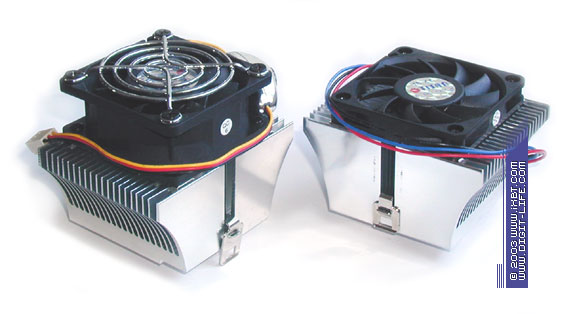 Left to right: Titan TTC-D6TB(A) and TTC-D7TB The thermal effectiveness is worse than average. The noise level is acceptable, but I can't call these coolers noiseless at all. The only interesting feature is the fan's alarm system in TTC-D6TB(A) which warns you when the fan slows down or stops, though this bonus doesn't help it much to restore its health. TTC-D6TB(A) and TTC-D7TB drag in the tail of the technical rating though they manage to nudge out some other budget models. TTC-D5TB(3) and TTC-D5TB(TC) are the basic Titan's solutions with a pretty big extrusion heatsink, 80x80x35 mm (55x60 mm base) and a fan of 80x80x25 mm which make us feel more optimistic about their performance. 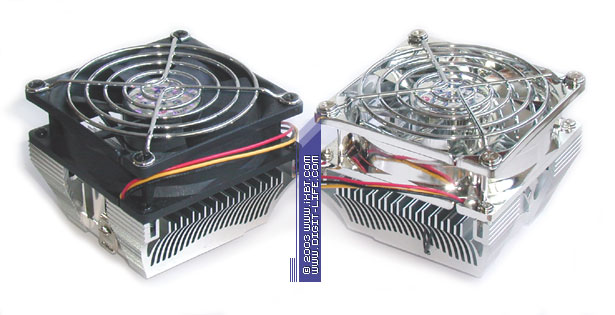 Left to right: Titan TTC-D5TB(3) and TTC-D5TB(TC) These models are more effective than their budget competitors and produce less noise, that is why they take high positions in the technical rating. However, there is one tricky aspect. TTC-D5TB(TC) officially supports temperature control. But the fan's speed hardly changes as the heatsink thermal load goes up or down (the fan speed hovers around 2000-2100 rpm plus-minus a maximum of 100 rpm for different test samples). The temperature control is thus rather weak, and TTC-D5TB(TC) can be considered just a tuned version of ordinary TTC-D5TB with a lower noise level. :) Titan TTC-CU5TBTTC-CU5TB is the top Titan's Socket A model, and its design reminds Evercool's CUD-725. It's built on the same copper heatsink, 70x65x35 mm (55x65 mm base), based on the bonded fin technology; but it comes with a smaller fan (70x70x15 mm) in a pretty aluminum case.  Titan TTC-CU5TB TTC-CU5TB has thermal parameters similar to CUD-725 and works as efficiently as its prototype. But its noise level is loads greater (52 dBA) because of the aggressive impeller design and high rotational speed (5000 rpm). As a result, TTC-CU5TB falls far behind CUD-725 and goes down to the end of the technical rating. Its position in the economic table is not high either because of its unattractive price. Zalman CNPS3000-Plus, CNPS3100-Plus and CNPS3100-GPZalman cooling systems caught our eye two years ago and made an incredible impression with their pleasant appearance, nontraditional design and a good set of technical characteristics. CNPS3000-Plus, CNPS3100-Plus and CNPS3100-GP are the forefathers in the Zalman's line, but they are still attractive. The most intriguing feature is the unique heatsink, 52x110x65 mm, based on the Flower Heatsink technology (a bunch of pressed plates on the alloyed base) - the heatsink is made of copper and aluminum on CNPS3000-Plus, and of copper on CNPS3100-Plus and CNPS3100-GP (the latter is coated with gold). 
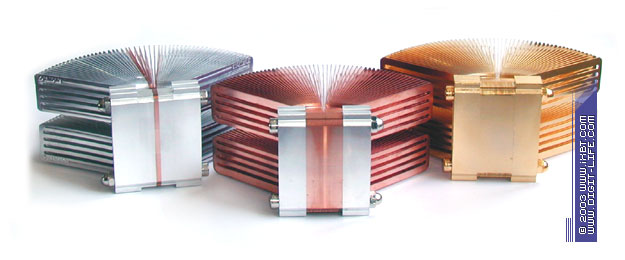 Left to right: heatsinks of Zalman CNPS3000-Plus, CNPS3100-Plus and CNPS3100-GP The fan (92x92x25 mm, 2800 rpm) is fixed on a special holder which in mounted in the case and allows shifting the fan relative to the heatsink. CNPS3000-Plus, CNPS3100-Plus and CNPS3100-GP come bundled with a special installation tool (steel stick with a handle) that helps you to fix the heatsink in the socket, and a power supply adapter reducing the number of revolutions to 1600 rpm. 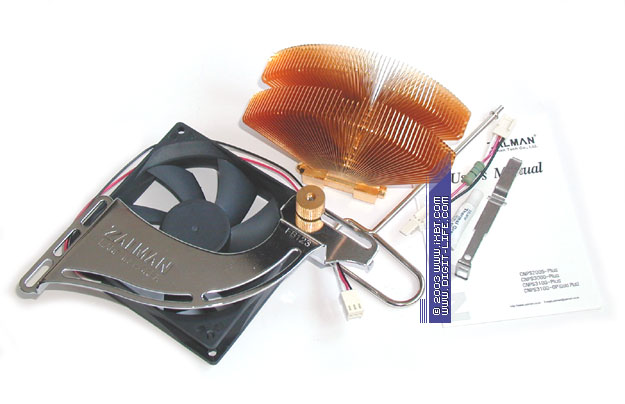 But the combination of their features isn't so attractive as it was 1.5 years ago. CNPS3000-Plus, CNPS3100-Plus and CNPS3100-GP lose even to the plain budget solutions from other manufacturers; in the Silent Mode (with the fan connected via the power supply adapter) they perform even worse. CNPS3000-Plus is the least effective cooler. In the long run, despite their unique design CNPS3000-Plus, CNPS3100-Plus and CNPS3100-GP look rather pale in the technical rating. The hefty fee makes them real outsiders in the economical rating. Zalman CNPS6000-AlCu and CNPS6000-CuTwo new Zalman Socket A coolers - CNPS6000-AlCu and CNPS6000-Cu extend the line of CNPS3000-Plus and CNPS3100-Plus offering the same principle of separate mounting of a fan, 92x92x25 mm (with an external holder) and a flower heatsink. But the heatsink gained some weight (63x110x65 mm) and got an advanced aerodynamic configuration of flower plates. 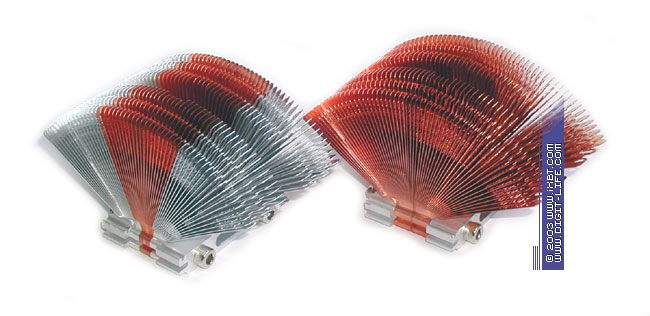
 Left to right: heatsinks of Zalman CNPS6000-AlCu and CNPS6000-Cu The coolers come with the same pleasant accessories. But a plain power supply reduction adapter is replaced with the Fan Mate I that allows gradually varying the rotational speed from 2800 rpm (Normal Mode) to 1600 rpm (Silent Mode).  CNPS6000-AlCu and CNPS6000-Cu edge out their predecessors, with CNPS6000-Cu getting even into the leading group. But in the Silent Mode these solutions are not able to stand against the leaders. Nevertheless, their ergonomic design helps CNPS6000-AlCu and CNPS6000-Cu take quite high positions in the technical rating, and CNPS6000-Cu in the Normal Mode gets into Top Ten. Well, now when we are through with eyeing the contestants let's go further and benchmark them. Note: several coolers (GlacialTech Igloo 2310, GlacialTech Igloo 2400, Cooler Master DP5-6I31C-0L) were not described above. GlacialTech Igloo 2310 and Igloo 2400 were thoroughly studied before and need no more comments. Cooler Master DP5-6I31C-0L is almost a twin of DP5-6I31C, - it just has a quieter fan, 60x60x25 mm, and a new rather unpleasant mount. But still, their temperature results, noise level and other parameters are brought into the Test Results and Table of Ranks. Part 4. Test Results (temperature, thermal resistance, noise level)
Part 5. Ratings (technical-economical coolers map, technical and economical ratings)
Appendix. Coolers consumer qualities assessment (new edition)
Vitaly Krinitsin (vit@ixbt.com)
Write a comment below. No registration needed!
|
Platform · Video · Multimedia · Mobile · Other || About us & Privacy policy · Twitter · Facebook Copyright © Byrds Research & Publishing, Ltd., 1997–2011. All rights reserved. |